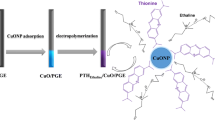Abstract
The development of a disposable electrochemical paper-based analytical device (ePAD) is described using a novel formulation of conductive ink that combines graphite powder, polyester resin, and acetone. As a proof of concept, the proposed sensor was utilized for paracetamol (PAR) sensing. The introduced ink was characterized via morphological, structural, and electrochemical analysis, and the results demonstrated appreciable analytical performance. The proposed ePAD provided linear behavior (R2 = 0.99) in the concentration range between 1 and 60 µmol L−1, a limit of detection of 0.2 µmol L−1, and satisfactory reproducibility (RSD ~ 7.7%, n = 5) applying a potential of + 0.81 V vs Ag at the working electrode. The quantification of PAR was demonstrated in different pharmaceutical formulations. The achieved concentrations revealed good agreement with the labeled values, acceptable accuracy (101% and 106%), and no statistical difference from the data obtained by HPLC at the 95% confidence level. The environmental impact of the new device was assessed using AGREE software, which determined a score of 0.85, indicating that it is eco-friendly. During the pharmacokinetic study of PAR, it was found that the drug has a maximum concentration of 23.58 ± 0.01 µmol L−1, a maximum time of 30 min, and a half-life of 2.15 h. These results are comparable to other studies that utilized HPLC. This suggests that the combination of graphite powder and polyester resin can transform conductive ink into an effective ePAD that can potentially be used in various pharmaceutical applications.
Graphical abstract







Similar content being viewed by others
Data availability
The data generated and analyzed during the development of this study are inserted in the published article and its supplementary material files.
References
The Unsaturated Polyester Resin Market Size | Global Industry Forecast. https://www.marketsandmarkets.com/Market-Reports/unsaturated-polyester-resin-upr-market-891.html?gclid=CjwKCAjw9J2iBhBPEiwAErwpeenvFvnemZLGlvCF977_H4yFLNDd8q2XtPGD62NPoGFHihovZntoGRoCAOUQAvD_BwE. Accessed 24 Apr 2023
Aziz SH, Ansell MP, Clarke SJ, Panteny SR (2005) Modified polyester resins for natural fibre composites. Compos Sci Technol 65:525–535. https://doi.org/10.1016/j.compscitech.2004.08.005
Parmar MS (2014) Dicarboxylic acid. Encyclopedia of Toxicology: Third Edition 76–79. https://doi.org/10.1016/B978-0-12-386454-3.01217-3
Kim Y, Lee B, Yang S et al (2012) Use of copper ink for fabricating conductive electrodes and RFID antenna tags by screen printing. Curr Appl Phys 12:473–478. https://doi.org/10.1016/j.cap.2011.08.003
Phillips C, Al-Ahmadi A, Potts SJ et al (2017) The effect of graphite and carbon black ratios on conductive ink performance. J Mater Sci 52:9520–9530. https://doi.org/10.1007/s10853-017-1114-6
Islam R, Khair N, Ahmed DM, Shahariar H (2019) Fabrication of low cost and scalable carbon-based conductive ink for E-textile applications. Mater Today Commun 19:32–38. https://doi.org/10.1016/J.MTCOMM.2018.12.009
Khair N, Islam R, Shahariar H (2019) Carbon-based electronic textiles: materials, fabrication processes and applications. J Mater Sci 54:10079–10101
Stefano JS, Orzari LO, Silva-Neto HA et al (2022) Different approaches for fabrication of low-cost electrochemical sensors. Curr Opin Electrochem 32:100893. https://doi.org/10.1016/j.coelec.2021.100893
Noviana E, Klunder KJ, Channon RB, Henry CS (2019) Thermoplastic electrode arrays in electrochemical paper-based analytical devices. Anal Chem 91:2431–2438. https://doi.org/10.1021/acs.analchem.8b05218
Noviana E, McCord CP, Clark KM et al (2020) Electrochemical paper-based devices: Sensing approaches and progress toward practical applications. Lab Chip 20:9–34. https://doi.org/10.1039/c9lc00903e
Silva-Neto HA, Arantes IVS, Ferreira AL et al (2023) Recent advances on paper-based microfluidic devices for bioanalysis. TrAC – Trends Anal Chem 158:116893. https://doi.org/10.1016/j.trac.2022.116893
Rocha D, Silva-Neto H, Oliveira L, et al (2021) Disposable stencil-printed carbon electrodes for electrochemical analysis of sildenafil citrate in commercial and adulterated tablets. Braz J Anal Chem. https://doi.org/10.30744/brjac.2179-3425.ar-65-2021
de Lima LF, Ferreira AL, Maciel CC et al (2021) Disposable and low-cost electrochemical sensor based on the colorless nail polish and graphite composite material for tartrazine detection. Talanta 227:122200. https://doi.org/10.1016/j.talanta.2021.122200
Sousa LR, Silva-Neto HA, Castro LF, et al (2023) “Do it yourself” protocol to fabricate dual-detection paper-based analytical device for salivary biomarker analysis. Anal BioanalChem 1–10. https://doi.org/10.1007/s00216-023-04581-2
Silva-Neto HA, Duarte-Junior GF, Rocha DS et al (2023) Recycling 3D printed residues for the development of disposable paper-based electrochemical sensors. ACS Appl Mater Interfaces 15:14111–14121. https://doi.org/10.1021/acsami.3c00370
De Souza DC, Orzari LO et al (2021) Electrochemical sensor based on beeswax and carbon black thin biofilms for determination of paraquat in Apis Mellifera honey. Food Anal Methods 14:606–615. https://doi.org/10.1007/s12161-020-01900-6
Adkins JA, Noviana E, Henry CS (2016) Development of a quasi-steady flow electrochemical paper-based analytical device. Anal Chem 88:10639–10647. https://doi.org/10.1021/acs.analchem.6b03010
Shitanda I, Takamatsu S, Watanabe K, Itagaki M (2009) Amperometric screen-printed algal biosensor with flow injection analysis system for detection of environmental toxic compounds. Electrochim Acta 54:4933–4936. https://doi.org/10.1016/j.electacta.2009.04.005
Boumya W, Taoufik N, Achak M, Barka N (2021) Chemically modified carbon-based electrodes for the determination of paracetamol in drugs and biological samples. J Pharm Anal 11:138–154. https://doi.org/10.1016/J.JPHA.2020.11.003
Noviana E, Carrão DB, Pratiwi R, Henry CS (2020) Emerging applications of paper-based analytical devices for drug analysis: a review. Anal Chim Acta 1116:70–90. https://doi.org/10.1016/j.aca.2020.03.013
Kang X, Wang J, Wu H et al (2010) A graphene-based electrochemical sensor for sensitive detection of paracetamol. Talanta 81:754–759. https://doi.org/10.1016/j.talanta.2010.01.009
Serrano N, Castilla Ò, Ariño C et al (2019) Commercial screen-printed electrodes based on carbon nanomaterials for a fast and cost-effective voltammetric determination of paracetamol, ibuprofen and caffeine in water samples. Sensors 19:4039. https://doi.org/10.3390/s19184039
de Oliveira TR, Fonseca WT, de Oliveira SG, Faria RC (2019) Fast and flexible strategy to produce electrochemical paper-based analytical devices using a craft cutter printer to create wax barrier and screen-printed electrodes. Talanta 195:480–489. https://doi.org/10.1016/J.TALANTA.2018.11.047
Taouri L, Bourouina M, Bourouina S, Hauchard D (2022) A new highly sensitive micro-sensor for the ultra-traces analysis of paracetamol directly in water. Microchem J 178:107380. https://doi.org/10.1016/j.microc.2022.107380
Tsvetkova B (2012) Simultaneous high-performance liquid chromatography determination of paracetamol and ascorbic acid in tablet dosage forms. Afr J Pharm Pharmacol 6:1332–1336. https://doi.org/10.5897/ajpp12.163
Behera S (2012) UV-visible spectrophotometric method development and validation of assay of paracetamol tablet formulation. J Anal Bioanal Tech 03:1000151. https://doi.org/10.4172/2155-9872.1000151
Bosch ME, Sánchez AJR, Rojas FS, Ojeda CB (2006) Determination of paracetamol: historical evolution. J Pharm Biomed Anal 42:291–321. https://doi.org/10.1016/J.JPBA.2006.04.007
Katseli V, Economou A, Kokkinos C (2020) A novel all-3D-printed cell-on-a-chip device as a useful electroanalytical tool: application to the simultaneous voltammetric determination of caffeine and paracetamol. Talanta 208:120388. https://doi.org/10.1016/J.TALANTA.2019.120388
Tefera M, Geto A, Tessema M, Admassie S (2016) Simultaneous determination of caffeine and paracetamol by square wave voltammetry at poly(4-amino-3-hydroxynaphthalene sulfonic acid)-modified glassy carbon electrode. Food Chem 210:156–162. https://doi.org/10.1016/j.foodchem.2016.04.106
Silva-Neto HA, Cardoso TMG, McMahon CJ et al (2021) Plug-and-play assembly of paper-based colorimetric and electrochemical devices for multiplexed detection of metals. Analyst 146:3463–3473. https://doi.org/10.1039/d1an00176k
Pena-Pereira F, Wojnowski W, Tobiszewski M (2020) AGREE - Analytical GREEnness metric approach and software. Anal Chem 92:10076–10082. https://doi.org/10.1021/acs.analchem.0c01887
Kissinger PT (1983) Heineman WR cyclic voltammetry. J Chem Educ 60:702. https://doi.org/10.1021/ed060p702
Arduini F, Cinti S, Mazzaracchio V et al (2020) Carbon black as an outstanding and affordable nanomaterial for electrochemical (bio)sensor design. Biosens Bioelectron 156:112033. https://doi.org/10.1016/j.bios.2020.112033
Demir N, Atacan K, Ozmen M, Bas SZ (2020) Design of a new electrochemical sensing system based on MoS2-TiO2/reduced graphene oxide nanocomposite for the detection of paracetamol. New J Chem 44:11759–11767. https://doi.org/10.1039/d0nj02298e
Hazani NN, Mohd Y, Ghazali SAISM et al (2019) Electrochemical studies on corrosion inhibition behaviour of synthesised 2-acetylpyridine 4-ethyl-3-thiosemicarbazone and its Tin(IV) complex for mild steel in 1 M HCl solution. J Electrochem Sci Technol 10:29–36. https://doi.org/10.5229/JECST.2019.10.1.29
Chandra P, Son NX, Noh HB et al (2013) Investigation on the downregulation of dopamine by acetaminophen administration based on their simultaneous determination in urine. Biosens Bioelectron 39:139–144. https://doi.org/10.1016/J.BIOS.2012.07.006
Babaei A, Garrett DJ, Downard AJ (2011) Selective simultaneous determination of paracetamol and uric acid using a glassy carbon electrode modified with multiwalled Carbon nanotube/chitosan composite. Electroanalysis 23:417–423. https://doi.org/10.1002/elan.201000406
Tanuja SB, Kumara Swamy BE, Pai KV (2017) Electrochemical determination of paracetamol in presence of folic acid at nevirapine modified carbon paste electrode: a cyclic voltammetric study. J Electroanal Chem 798:17–23. https://doi.org/10.1016/J.JELECHEM.2017.05.025
Fu L, Xie K, Zheng Y et al (2018) Graphene ink film based electrochemical detector for paracetamol analysis. Electronics 7:15. https://doi.org/10.3390/electronics7020015
Mangaiyarkarasi R, Premlatha S, Khan R et al (2020) Electrochemical performance of a new imidazolium ionic liquid crystal and carbon paste composite electrode for the sensitive detection of paracetamol. J Mol Liq 319:114255. https://doi.org/10.1016/J.MOLLIQ.2020.114255
Saciloto TR, Cervini P, Cavalheiro ÉTG (2013) Simultaneous voltammetric determination of acetaminophen and caffeine at a graphite and polyurethane screen-printed composite electrode. J Braz Chem Soc 24:1461–1468. https://doi.org/10.5935/0103-5053.20130186
Okoth OK, Yan K, Liu L, Zhang J (2016) Simultaneous electrochemical determination of paracetamol and diclofenac based on poly(diallyldimethylammonium chloride) functionalized graphene. Electroanalysis 28:76–82. https://doi.org/10.1002/elan.201500360
Jeevagan AJ, John SA (2012) Electrochemical determination of caffeine in the presence of paracetamol using a self-assembled monolayer of non-peripheral amine substituted copper(II) phthalocyanine. Electrochim Acta 77:137–142. https://doi.org/10.1016/j.electacta.2012.05.090
Karki S, Friščić T, Fabián L et al (2009) Improving mechanical properties of crystalline solids by cocrystal formation: new compressible forms of paracetamol. Adv Mater 21:3905–3909. https://doi.org/10.1002/ADMA.200900533
Battu PR, Reddy MS (2009) RP-HPLC Method for simultaneous estimation of paracetamol and ibuprofen in tablets. Asian J Research Chem 2:70–72. https://doi.org/10.1094/PDIS.2001.85.8.879
Cetinkaya A, Yıldız E, Kaya SI et al (2022) A green synthesis route to develop molecularly imprinted electrochemical sensor for selective detection of vancomycin from aqueous and serum samples. Green Anal Chem 2:100017. https://doi.org/10.1016/j.greeac.2022.100017
World Health Organization (1975) Guidelines for evaluation of drugs for use in man: report of a WHO scientific group. https://apps.who.int/iris/handle/10665/41149. Accessed 19 July 2023
Bertolini A, Ferrari A, Ottani A et al (2006) Paracetamol: new vistas of an old drug. CNS Drug Rev 12:250–275. https://doi.org/10.1111/j.1527-3458.2006.00250.x
Mazaleuskaya LL, Sangkuhl K, Thorn CF et al (2015) PharmGKB summary: Pathways of acetaminophen metabolism at the therapeutic versus toxic doses. Pharmacogenet Genomics 25:416–426. https://doi.org/10.1097/FPC.0000000000000150
Forrest JAH, Clements JA, Prescott LF (1982) Clinical pharmacokinetics of paracetamol. Clin Pharmacokinet 7:93–107. https://doi.org/10.2165/00003088-198207020-00001/METRICS
McGill MR, Jaeschke H (2013) Metabolism and disposition of acetaminophen: recent advances in relation to hepatotoxicity and diagnosis. Pharm Res 30:2174–2187
Acknowledgements
The authors acknowledge the Multi-user Laboratory of high-resolution microscopy (LabMic/UFG) for using their facilities during (SEM and Raman) measurements. The Laboratory of Clinical Analysis and Health Education (LACES) of the Biological Sciences Institute from Federal University, Dr. Gabriela Bazílio, and Professor Gabriela Duarte are also acknowledged for using their facilities during the sample preparation and manipulation.
Funding
The authors would like to thank CAPES (finance code 88887.192880/2018–00 and 001), CNPq (grants 307554/2020–1, 405620/2021–7, 142412/2020–1, and 146507/2022–3) and INCTBio (grant 465389/2014–7) for the financial support and granted scholarships and researcher fellowship.
Author information
Authors and Affiliations
Corresponding author
Ethics declarations
Conflict of interest
The authors declare no competing interests.
Additional information
Publisher's note
Springer Nature remains neutral with regard to jurisdictional claims in published maps and institutional affiliations.
Supplementary Information
Below is the link to the electronic supplementary material.
Rights and permissions
Springer Nature or its licensor (e.g. a society or other partner) holds exclusive rights to this article under a publishing agreement with the author(s) or other rightsholder(s); author self-archiving of the accepted manuscript version of this article is solely governed by the terms of such publishing agreement and applicable law.
About this article
Cite this article
Oliveira, L.C., Rocha, D.S., Silva-Neto, H.A. et al. Polyester resin and graphite flakes: turning conductive ink to a voltammetric sensor for paracetamol sensing. Microchim Acta 190, 324 (2023). https://doi.org/10.1007/s00604-023-05914-9
Received:
Accepted:
Published:
DOI: https://doi.org/10.1007/s00604-023-05914-9




